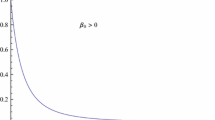Abstract
We discuss the relationship between the Coulomb gauge, the existence of an invariant axis, and the dimensionality (2-D or 2\(\frac {1}{2}\)-D) of the magnetic field in a mathematical-physical formalism that leads us to the Grad-Shafranov (GS) equation. In the literature, we found that a 2-D magnetic structure is used as a prerequisite to derive the GS equation from the Vlasov equation. However, other consulted works are based on a 2\(\frac {1}{2}\)-D (two-and-a-half) magnetic structure as a prerequisite to derive the GS equation from the balance of forces between the pressure gradient and the magnetic force, respectively. We replaced the magnetic vector potential on Ampère’s equation and used the Coulomb gauge to obtain a system of three Poisson equations, one for each component. We also used the same procedure explained above, but without the Coulomb gauge. Comparing z-component in both equation systems, we concluded that there are two possible solutions. We suggest using a 2\(\frac {1}{2}\)-D magnetic field configuration instead of a 2-D, when working with kinetic theory or magnetostatic equilibrium to derive the GS equation. We clarified that there is no relationship between the Coulomb gauge and the magnetic field dimensionality. In this problem, the invariant axis condition is imposed, which means that \(\vec {\nabla }\cdot \vec {A}\) is independent of z, i.e., \(\vec {\nabla }\cdot \vec {A}\) could have any value in which an invariant axis is a sufficient condition to obtain the GS equation.
Similar content being viewed by others
References
N. Al-Haddad, I.I. Roussev, C. Möstl, C. Jacobs, N. Lugaz, S. Poedts, C.J. Farrugia, On the internal structure of the magnetic field in magnetic clouds and interplanetary coronal mass ejections: Writhe versus twist. Astrophys. J. Lett. 738(2), L18 (2011)
D. Du, C. Wang, Q. Hu, Propagation and evolution of a magnetic cloud from ACE to Ulysses. J. Geophys. Res. 112(A9) (2007)
H. Hasegawa, R. Nakamura, M. Fujimoto, V.A. Sergeev, E.A. Lucek, H. Reme, Y. Khotyaintsev, Reconstruction of a bipolar magnetic signature in an earthward jet in the tail: Flux rope or 3D guide-field reconnection? J. Geophys. Res. 112(A11), A11206 (2007)
H. Hasegawa, B. Sonnerup, C. Owen, B. Klecker, G. Paschmann, A. Balogh, H. Reme, The structure of flux transfer events recovered from cluster data. Ann. Geophys. 24(2), 603–618 (2006)
H. Hasegawa, B.U.Ö. Sonnerup, B. Klecker, G. Paschmann, M. W. Dunlop, H. Reme, Optimal reconstruction of magnetopause structures from cluster data. Ann. Geophys. 23, 973–982 (2005)
L.-N. Hau, B.U.Ö. Sonnerup, Two-dimensional coherent structures in the magnetopause: recovery of static equilibria from single-spacecraft data. J. Geophys. Res. 104(A4), 6899–6917 (1999)
Q. Hu, C.W. Smith, N.F. Ness, R.M. Skoug, Multiple flux rope magnetic ejecta in the solar wind. J. Geophys. Res. Space. 109, 3102 (2004)
Q. Hu, B. Sonnerup, Reconstruction of magnetic clouds in the solar wind: orientations and configurations. J. Geophys. Res. 107(A7), 1142 (2002)
Q. Hu, B.U.Ö. Sonnerup, Magnetopause transects from two spacecraft: a comparison. Geophys. Res. Lett. 27(10), 1443–1446 (2000)
Q. Hu, B.U.Ö. Sonnerup, Reconstruction of magnetic flux ropes in the solar wind. J. Geophys. Res. 28(3), 467–470 (2001)
Q. Hu, B.U.Ö. Sonnerup, Reconstruction of two-dimensional structures in the magnetopause: Method improvements. J. Geophys. Res. 108(A1), 1011 (2003)
A. Isavnin, E. Kilpua, H. Koskinen, Grad-Shafranov reconstruction of magnetic clouds: overview and improvements. Sol. Phys. 273(1), 205–219 (2011)
A.V. Khrabrov, B.U.Ö. Sonnerup, DeHoffmann-Teller analysis. ISSI Sci. Rep. Ser. 1, 221–248 (1998)
A.T.Y. Lui, Grad-Shafranov reconstruction of magnetic flux ropes in the near-Earth space. Space. Sci. Rev. 158, 43–68 (2011)
A.T.Y. Lui, D.G. Sibeck, T. Phan, V. Angelopoulos, J. McFadden, C. Carlson, D. Larson, J. Bonnell, K.-H. Glassmeier, S. Frey, Reconstruction of a magnetic flux rope from THEMIS observations. Geophys. Res. Lett. 351, 17 (2008)
C. Möstl, Modeling magnetic clouds using multi-spacecraft observations. Ph.D thesis, Institut für Physik Institutsbereich Geophysik, Astrophysik und Meteorologie (2009)
A. Ojeda González, M.O. Domingues, O. Mendes, M. Kaibara, A. Prestes, Grad-Shafranov reconstruction: overview and improvement of the numerical solution used in space physics. Braz. J. Phys. (2015)
P. Riley, J. Linker, R. Lionello, Z. Mikic, D. Odstrcil, M. Hidalgo, C. Cid, Q. Hu, R. Lepping, B. Lynch, A. Rees, Fitting flux ropes to a global {MHD} solution: a comparison of techniques. J. Atmos. Sol.-Terr. Phys. 66(15-16), 1321–1331 (2004). Towards an integrated model of the space weather system
B.U.Ö. Sonnerup, M. Guo, Magnetopause transects. Geophys. Res. Lett. 23(25), 3679–3682 (1996)
B.U.Ö. Sonnerup, H. Hasegawa, G. Paschmann, Anatomy of a flux transfer event seen by cluster. Geophys. Res. Lett. 31, L11803–L11803 (2004)
B.U.Ö. Sonnerup, H. Hasegawa, W.-L. Teh, L.-N. Hau, Grad-Shafranov reconstruction: an overview. J. Geophys. Res. 111(A09204), 1–12 (2006)
W.-L. Teh, A study of two-dimensional magnetopause structure based on Grad-Shafranov reconstruction method. Ph.D. thesis, Institute of Space Science, National Central University (2007)
W.-L. Teh, L.-N. Hau, Evidence for pearl-like magnetic island structures at dawn and dusk side magnetopause. Earth Planets Space. 56, L681 (2004)
W.-L. Teh, L.-N. Hau, Triple crossings of a string of magnetic islands at duskside magnetopause encountered by AMPTE/IRM satellite on 8 August 1985. J. Geophys. Res. 102(A8), A08207 (2007)
P.H. Yoon, A.T.Y. Lui, A class of exact two-dimensional kinetic current sheet equilibria. J. Geophys. Res. 110(A1), A01202 (2005)
Acknowledgments
This work was supported by grants from FVE (Fundação Valeparaibana de Ensino)-UNIVAP and CNPq (grant 301441/2013-8). We are very grateful by the excellent comments (questions and ideas to improve the text) raised by the anonymous reviewer.
Author information
Authors and Affiliations
Corresponding author
Rights and permissions
About this article
Cite this article
González, A.O., Prestes, A. & Laurindo Sousa, A.N. Discussion About the Magnetic Field Dimensionality, Invariant Axis Condition, and Coulomb Gauge to Solve the Grad-Shafranov Equation. Braz J Phys 46, 408–414 (2016). https://doi.org/10.1007/s13538-016-0422-7
Received:
Published:
Issue Date:
DOI: https://doi.org/10.1007/s13538-016-0422-7



